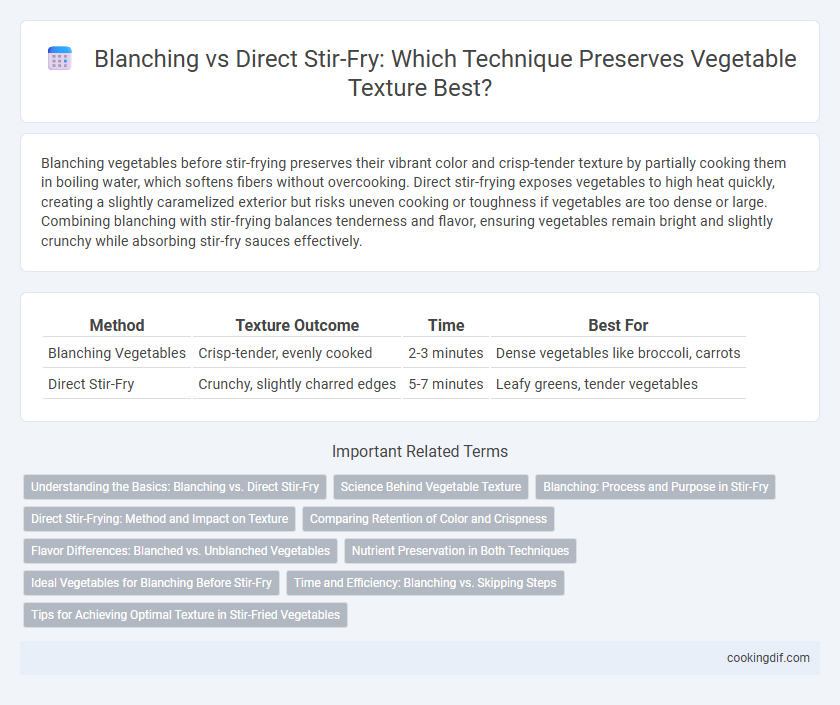Blanching vegetables before stir-frying preserves their vibrant color and crisp-tender texture by partially cooking them in boiling water, which softens fibers without overcooking. Direct stir-frying exposes vegetables to high heat quickly, creating a slightly caramelized exterior but risks uneven cooking or toughness if vegetables are too dense or large. Combining blanching with stir-frying balances tenderness and flavor, ensuring vegetables remain bright and slightly crunchy while absorbing stir-fry sauces effectively.
Table of Comparison
| Method | Texture Outcome | Time | Best For |
|---|---|---|---|
| Blanching Vegetables | Crisp-tender, evenly cooked | 2-3 minutes | Dense vegetables like broccoli, carrots |
| Direct Stir-Fry | Crunchy, slightly charred edges | 5-7 minutes | Leafy greens, tender vegetables |
Understanding the Basics: Blanching vs. Direct Stir-Fry
Blanching vegetables before stir-frying preserves vibrant color and crisp texture by briefly boiling and then shocking them in cold water, which also reduces cooking time during stir-frying. Direct stir-fry exposes vegetables to high heat immediately, resulting in faster cooking but can cause uneven texture and potential overcooking. Understanding these methods helps achieve optimal texture and flavor in stir-fry dishes, balancing tenderness with crunch.
Science Behind Vegetable Texture
Blanching vegetables before stir-frying preserves cell structure by partially cooking them and inactivating enzymes that cause spoilage, resulting in a crisp-tender texture. Direct stir-frying exposes vegetables to high heat quickly, causing rapid water evaporation and softening cell walls, which can lead to a more tender or slightly wilted texture. The science behind vegetable texture in stir-frying involves controlling moisture content and cell wall integrity to achieve the desired balance between crunchiness and tenderness.
Blanching: Process and Purpose in Stir-Fry
Blanching vegetables in stir-fry involves briefly boiling them in water, then plunging into ice water to halt cooking, preserving vibrant color and crisp texture. This process softens tougher vegetables like broccoli or carrots, ensuring even cooking when stir-fried at high heat, preventing undercooked centers or burnt exteriors. Blanching enhances texture by maintaining firmness and reduces overall stir-fry cooking time, contributing to a balanced and visually appealing dish.
Direct Stir-Frying: Method and Impact on Texture
Direct stir-frying involves cooking vegetables quickly over high heat in a small amount of oil, which preserves their natural crunch and vibrant color. This method enhances texture by sealing in moisture and creating a slight caramelization on the surface, resulting in a crisp-tender bite. Unlike blanching, direct stir-frying maintains the vegetables' fresh flavor and nutrient content, making it a preferred technique for achieving optimal texture in dishes like stir-fried broccoli or bell peppers.
Comparing Retention of Color and Crispness
Blanching vegetables before stir-frying enhances color retention and maintains a vibrant, crisp texture by halting enzymatic activity and softening fibers. Direct stir-frying can lead to color fading and uneven crispness due to higher heat exposure and shorter cooking times. Blanched vegetables also resist sogginess, preserving a desirable firmness that improves overall mouthfeel in stir-fry dishes.
Flavor Differences: Blanched vs. Unblanched Vegetables
Blanching vegetables before stir-frying preserves vibrant color and tender-crisp texture while slightly mellowing their natural flavors, resulting in a milder taste profile. Direct stir-frying intensifies vegetable flavor through caramelization and Maillard reactions, offering a richer, more robust taste with a firmer bite. Choosing between blanching and direct stir-fry affects not only texture but also the depth and complexity of flavor in the final dish.
Nutrient Preservation in Both Techniques
Blanching vegetables before stir-frying helps retain vibrant color and crunch while preserving water-soluble vitamins like vitamin C and B-complex, which can be lost during prolonged cooking. Direct stir-fry exposes vegetables to high heat for a short time, preserving antioxidants and phytochemicals but may cause slight nutrient degradation due to intense heat. Combining blanching with quick stir-frying optimizes texture and maximizes nutrient retention, balancing crispness and vitamin preservation.
Ideal Vegetables for Blanching Before Stir-Fry
Blanching vegetables like broccoli, green beans, and carrots before stir-frying enhances their texture by partially cooking them, preserving vibrant color and crispness while reducing overall stir-fry time. This method is ideal for denser vegetables that require longer cooking to achieve tenderness without overcooking the stir-fry ingredients. Leafy greens and tender vegetables, such as spinach and bell peppers, are better suited for direct stir-frying to maintain their delicate texture and flavor.
Time and Efficiency: Blanching vs. Skipping Steps
Blanching vegetables before stir-frying reduces overall cooking time by partially softening them, ensuring a more consistent texture and vibrant color. Skipping blanching streamlines preparation but requires precise heat control to avoid uneven cooking or sogginess. Efficient kitchens balance blanching and direct stir-fry methods to optimize texture while minimizing total cooking duration.
Tips for Achieving Optimal Texture in Stir-Fried Vegetables
Blanching vegetables before stir-frying helps preserve vibrant color and crisp-tender texture by halting enzymatic processes and softening fibers. Direct stir-frying, when done with high heat and quick tossing, retains the natural crunch but may result in uneven cooking if the vegetables vary in size or density. To achieve optimal texture, blanch dense vegetables like carrots or broccoli briefly, then combine with quicker-cooking items during the final stir-fry for balanced tenderness and freshness.
Blanching vegetables vs direct stir-fry for texture Infographic

 cookingdif.com
cookingdif.com